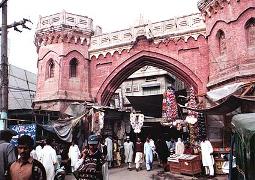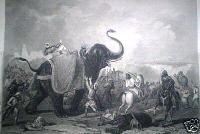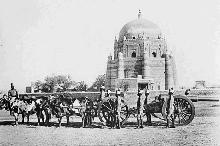MULTAN-E-MAA BA JANNAT-E- OULAA BRABAR AST
AAHIsTAH PAA BNEH KEH MALAK SAJDAH MIKUNAND
(AMEER KHUSROO)
A haven of sun, citrus and mango farms,
With clear water richgreen and sunshine.
 Multan has been a most important city of Hind and Sindh for a period of about 3000 years. It was strategically placed, on the main trade routes at the confluence the Ravi and Chanab Rivers, It has been a rich and well defended city for thousands of years. In 324 BC the Macedonians under Alexander invaded Multan and, it was here that he was seriously wounded, which caused his death later as he retreated.
Multan has been a most important city of Hind and Sindh for a period of about 3000 years. It was strategically placed, on the main trade routes at the confluence the Ravi and Chanab Rivers, It has been a rich and well defended city for thousands of years. In 324 BC the Macedonians under Alexander invaded Multan and, it was here that he was seriously wounded, which caused his death later as he retreated.
"He happened to land on his feet behind a fig tree….He slashed with his sword and hurled any stone that came to hand: the 'Multanis' recoiled as his three attendants leapt down to join him, carrying the sacred shield (Achilles). But Multani skill of archery were his undoing; his helpers were wounded, and an arrow, three feet long, struck him through his corselet into his chest. Wheïn a Multani ran forward to finish him off, Alexander had strength enough to stab his attacker; then he collapsed, spurting blood, beneath the cover of his Trojan shield"
(Robin Lane Fox, Alexander the Great 1973)
" It was the Indus Valley's long bamboo bow which proved a major harassing weapons as it had much longer range than the Greek steel bow. The Sindhis could shoot at the greek boats along the river while staying out of range" Zubair
Multan has been later, part of Great Mauryan Empire. The city was coveted and sacked by white Huns. Xuan Zang, a Budhist pilgrim visited Multan in AD 641, describes the city as an agreeable and prosperous city. He wrote about the fabulous statue of sun god, which was cast in pure gold and ornamented by precious gems. The temple of Pra Halad (the sun temple) was responsible for Multan becoming prosperous centre of pilgrimage. The statue was broken up by different invaders, got repaired and finally destroyed by the emperor Aurangzeb in the 17th century. There are certain localities in Multan which have the word �soorij' as prefix, and there is a miraculous story of bringing the sun near to roast a piece of meat by Shah Shams Tabrez.
Mohammad-bin-Qasim conquered Multan in AD 711. Multan fell to Mahmood of Ghazni, "Before Thatha was added to sooba of Multan it extended in length from Ferozpur, on the present Sutleg to Siwistan (Sehwan) four hundred and three kos, and in breadth from Sitpur to Jaisalmir, one hundred and twenty-six kos. After Thatha was added thereunto, it extended to Kich and Makran…. On the east it adjoined the sarkar of Sarhind, on the north to Peshawer, on the south to sooba of Ajmir and on the west Kich and Makran…. Thatha now forms the forth sarkar of the Multan sooba". (Raverty). The city fell to Nadir Shah in AD 1739 and Ahmad Shah Abdali in AD1752. in AD1005. Syed Ali Hijve (Data Ganj Bakhsh) in his famous book "Kashf-al-Mahjoob" describes Lahore as a suburb of Multan. In 13th century holy men from all over the Muslim world, harassed by Mangols, flocked here and Multan become an influential political, religious and cultural centre. Temoor Ling (Tamer lane) took Multan in AD 1338. The Langahs ruled Multan as an independent state for four generations. The ancient boundaries of sooba of Multan as recorded in Aaeen-e-Akbari
 The tragic siege of Multan commenced in 1818, when Sikh forces captured Multan. Multanis fought bravely but the Sikh army had better Artillery. The valiant Nawab of Multan Muzaffer Khan Shaheed, along with his sons and daughter was martyred fighting against the Sikhs. Sawan Mal and Moolraj ruled Multan as Sikh governors.
The tragic siege of Multan commenced in 1818, when Sikh forces captured Multan. Multanis fought bravely but the Sikh army had better Artillery. The valiant Nawab of Multan Muzaffer Khan Shaheed, along with his sons and daughter was martyred fighting against the Sikhs. Sawan Mal and Moolraj ruled Multan as Sikh governors.
On the eve of second Sikh War in1948 AD, William Anderson and Alexander vans were sent to Multan to negotiate a settlement with Mulraj and were murdered. A sand stone obelisk stands 50 meters high on fort mound marking their graves in inscribed,
"…Wounded and forsaken
They could offer no resistance,
But hand in hand calmly awaited
The onset of the assailants…"
 Herbert Edwards assembled a force of Multani Pathans and captures Multan in 1849. The famous monuments of Multan are; Tomb of Rukn-e-Alam, Tomb of Baha-ud-Din Zakria, Tomb of Shah Shams Tabrez, Ali Muhammad Mosque, Phulhattan Mosque, Savi Mosque, Eidgah Mosque, Tomb of Syed Yousif Gerdazi, Tomb of Abdul Jalil, Tomb of Ali Akbar, Tomb of Baba Khwaja Awais and Tomb of Bibi Pak Daman.
Herbert Edwards assembled a force of Multani Pathans and captures Multan in 1849. The famous monuments of Multan are; Tomb of Rukn-e-Alam, Tomb of Baha-ud-Din Zakria, Tomb of Shah Shams Tabrez, Ali Muhammad Mosque, Phulhattan Mosque, Savi Mosque, Eidgah Mosque, Tomb of Syed Yousif Gerdazi, Tomb of Abdul Jalil, Tomb of Ali Akbar, Tomb of Baba Khwaja Awais and Tomb of Bibi Pak Daman.
Sun Temple
Hindus ruled over Multan for a thousand years or so. They might have built many buildings or edifices, may be of great interest and importance but it appears that almost all of these edifices might have been destroyed during the battles fought latter on. There are, however, three places of considerable antiquity of that period references of which are found in many books and travelogues. The most important place of the Hindu period was the "Sun Mandir" It was the most acknowledged worship place throughout the sub-continent as referred to in many books. It was situated on the old Fort Mound. Abu Rehan's story regarding the discovery of the gold based on the writings of Ali bin Mohammad Abu Mohammed Hindui is reproduced asunder:"Mohammad Qasim arose, and, with his generals, courtiers, guards and attendants, went into the temple, where he beheld an idol made of pure gold, its two eyes being of bright red rubies Mohammad Qasim, mistaking the idol for a man, drew his sword, intending to severe the head from the body; but the Brahmans, prostrating themselves before the conqueror, exclaimed: "O true Commander, this is the image which was made by Jibawaii, King of Multan, who concealed beneath it, in a reservoir. a treasure exceeding all limits and computation, and then departed". The Arab general thereupon ordered the idol to be removed, and an underground chamber was discovered , in which were found two hundred and thirty maunds of gold and forty huge jars filled with gold dust. On enquiring the cause of the great wealth of the city and the flourishing condition of its Mohammad Qasim was informed that it was due to the offerings made to the idol, which were brought from all parts of India. Al-Masudi, of Baghdad, who visited the valley of the Indus in 303 A.H. (915 AD), and wrote his much admired work "The Meadows of Gold", about the year 330 A. H. (942 AD), has left us a glowing account of the condition of Islam in South Asia in the beginning of the tenth century.Speaking the idol, AI-Masudi says: "People living in the distant parts of Sind and Hind travel to it to perform pilgrimage, and, in fulfillment of their vows and religious obligations, they make offerings of money, precious stones, perfumes of every kind, and aloe wood before it. The sovereign of Multan derives the principal part of his revenues from the valuable offerings made to the idol. When the faithful are harassed by the unbelievers marching against Multan, they bring out the idol and threaten to break it in pieces, or reduce it to ashes, and the assailants are thus ind duced to withdraw forth with "Istakhri recorded about the idol "Multan as being held in great veneration by the Hindus, who flock to it from all parts of India on religious pilgrimages, and make large offerings which are spent on the temple and its devotees. The temple of the idol is about 300 feet high, is spoken of as a strongly built edifice, situated in the market, the most thickly populated part of the town, between the streets of the ivory dealers and coppersmiths quarters. the idol, stood in the centre of the building under a cupola, around which lived the ministering priests and worshippers. It was set on a platform of brickwork, and was made of wood (no longer of gold, be it observed) in human shape, covered with red Cordova leather, and seated with the legs bent in quadrangular posture, the hands resting on the knees with the fingers all closed. Its two eyes of two red rubies, and its head was surmounted with a golden crown.
Soorij Kund
Another place was�Suraj Kund" (the pool of sun). It is about five miles to the South of Multan on the Bahawaipur Road. It was a place of great antiquity with the Hindus. It was a pond 132 feet in diameter and 10 feet deep when full of water. Sawn Mal, the Sikh Diwan surrounded 'it with an octagonal wall .lt was a place of pilgrimage till 1 947 and two fairs were held here annually. One on the 7th of the Vanishing moon of Bhadon, and the other on the 7th of the rising moon of Magh, the numbers having references to the seven hours of the Sun's Chariot, according to the Hindu mythology or the seven Rishies. According to the Hindu Pur-ans the Sun God (Suraj Devta) manifested here and had declared that whosoever shall bath in this tank, his sins will be forgiven and he will be benefited both in in this world and in the next. It is a neglected place now as it has lost all its charm. Third place, a shadow of which can be seen even today is the Mandir Parhahadpuri.
Shrines
The devastation of Khorasan and Western Iran, by Magol hords led to the settling in this city of a large number of pious and learned men and noble families like Gardezi Syeds and Qureshis from Khawarizm, amongst whom Sheikh Bahauddin Zakaria is a famous saint. About the same time Pir Shams Tabrez from Sabzwar and Kazi Qutubuddin from Kashan came to Multan. Baba Farid Shakar Ganj settled in Pakpattan. Khawaja Qutubaddin Bakhatair Kaki passed through to Delhi and Syed Jalal, the spiritual leader of many family in Multan, Muzafargarh and Bahawalpur, came to Uch, Sultan Sakhi Sarwar's father also emigrated from Bokhara to Sakot in Multan district. These venerable men contributed greatly to spreading Islam in this area. the saints and shrines of Multan have been attracting a large number of devotees all the year round. The shrines of one of the foremost scholars of Islam, Shaikh Bahauddin Zakaria is located in the fort. The Mausoleum was built by the saint himself. It has a unique style of architecture of that period, the mausoleum of Shah Rukn-e-Alam, the grandson of Sahikh Bahauddin Zakaria, is also located near the main gate of the Multan Fort. He was also a man of great religious and political influence.Besides its religious importance, the Mausoleum has a unique architectural value. Its dome is considered to be the second largest in the world after "Gol Gumbad" of Bijapur, India. The mausoleum has very rich geometrical patterns, calligraphy and colourful floral, mosaic and glazed tile work. The mausoleum has recently been given the Agha Khan Award for the best Muslim Architecture. The shrine is visited by devotees all the year round. The shrine of Hazrat Shams Sabzwari is located near Aamkhas Garden. Other shrines in Multan include that of Muhammad Yousaf Gardezi near Bohar Gate, Musa Pak. Shaheed inside the Pak. Gate, Total Mai near Haram Gate, Shah Ali Akbar, a descendant of Shah Shams Sabzwari, in Surajmiani and Bab Sarfa near Eidgah.Tomb of Rukn-e-Alam was built during 1320-24. It is a massive octagonal structure, 25.5 meters in diameter and 35 meters high. A striking feature of its elevation is the effect of its sloping sides, which have been emphasised by addition of turrets or minarets at each angle of the building. The hemispherical dome at the roof of the mausoleum is a superstructure about 18 meters in diameter. Although of bricks foundation, the building has been elaborately ornamented in dark blue, white and azure tiles. Bands of carved timbering have also been sunk into the walls at appropriate intervals to enhance the beauty.
Over the last two centuries Multan has devolved as the centre of the hides and skin trade in the subcontinent, and since Partition it has become the major cotton producing region of Pakistan. Spinning and weaving of both cotton and wool and the making of hand-knotted carpets are now imported industries. Multan has yet to gain its old status of a metropolis of central Pakistan.
To be continued and edited
Author: Ijaz bloach (Admin)
